SPB2201: Research Report on Asian Markets in Sport Business
VerifiedAdded on 2019/10/18
|10
|2818
|240
Report
AI Summary
This research report, focusing on the megatrend of "New Wealth New Talent: Developing Markets in Asia," investigates the significant shift in global power dynamics due to the economic growth of Asian countries like China and India, and their increasing investments in sports. The report explores the nature of this trend, highlighting the financial investments in elite athlete development and increased sports participation among citizens. It emphasizes the creation of new business opportunities in sports media rights, equipment, services, and events, supported by data on market growth in China and the impact of events like the Beijing Olympics. The report argues for the trend's significance for Australia, given its proximity to Asia, and examines its relationship with the megatrend of "Tracksuits to Business Suits," illustrating how increased financial resources have led to higher salaries for athletes and coaches. Recent research, including the CSIRO report, is cited to support the analysis, emphasizing the implications for Australian sports and potential business opportunities in broadcasting, events, and equipment. The report concludes by highlighting the implications of increased competition for Australian athletes and the need for strategic adaptation to capitalize on the emerging Asian market.
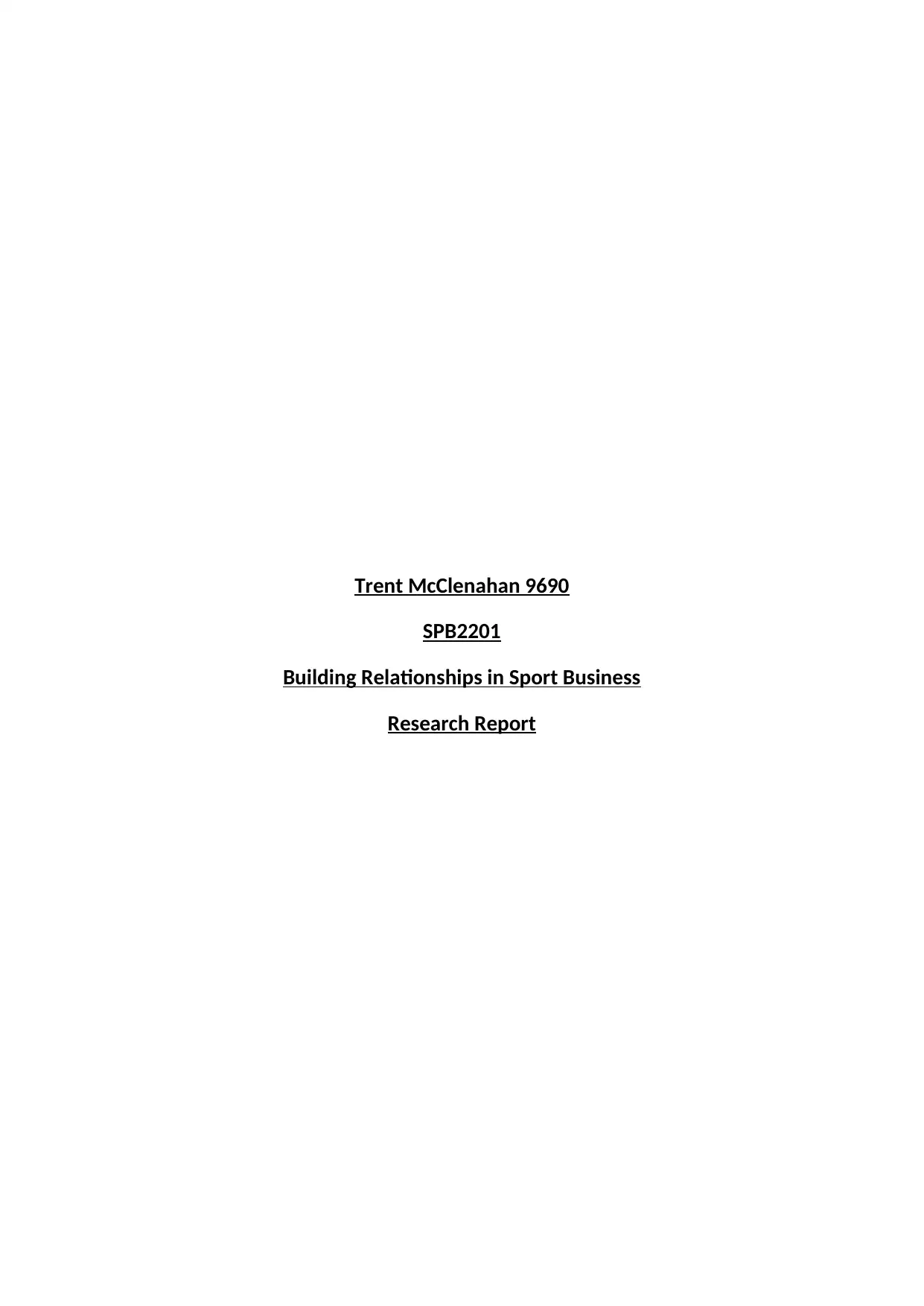
Trent McClenahan 9690
SPB2201
Building Relationships in Sport Business
Research Report
SPB2201
Building Relationships in Sport Business
Research Report
Paraphrase This Document
Need a fresh take? Get an instant paraphrase of this document with our AI Paraphraser
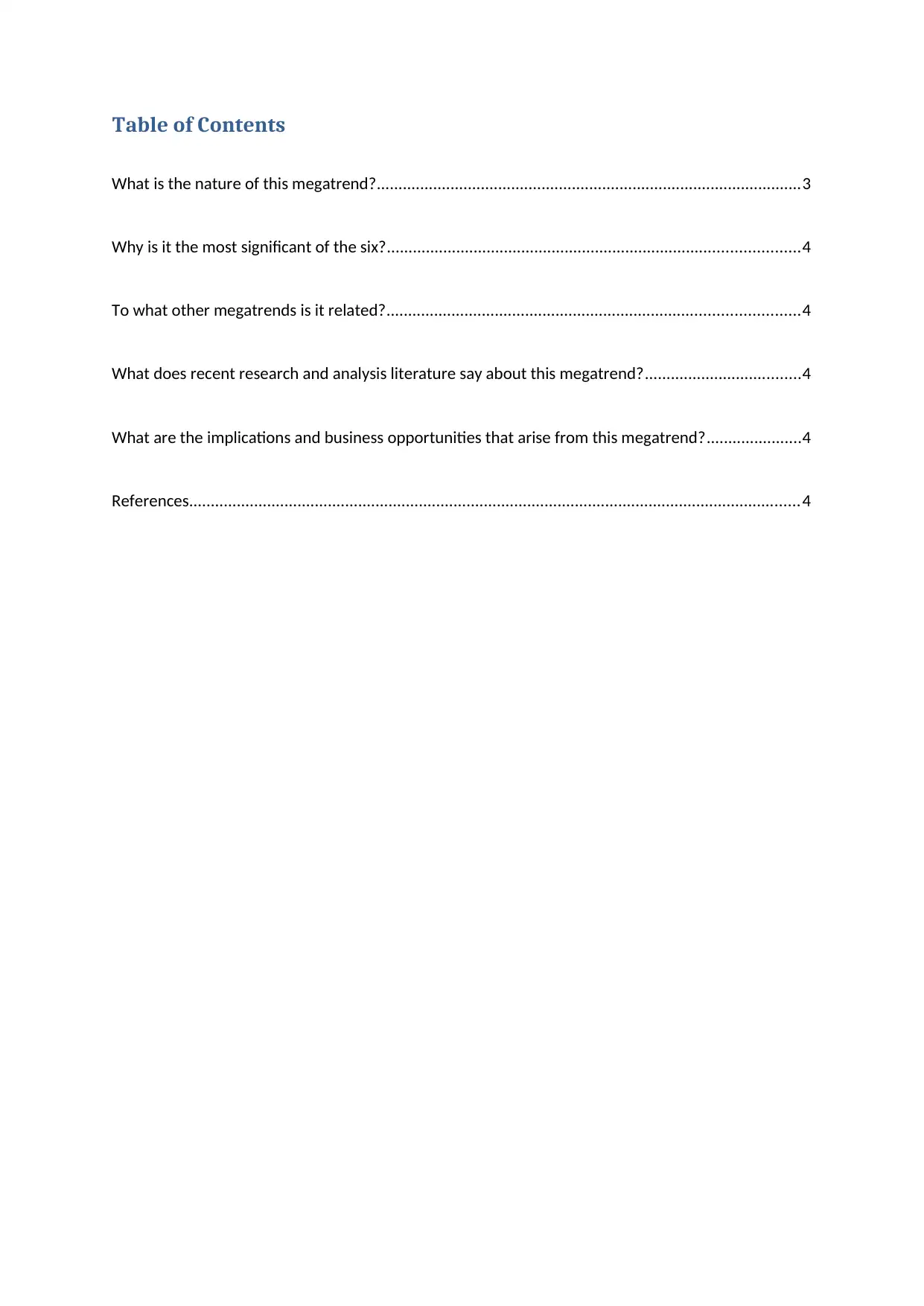
Table of Contents
What is the nature of this megatrend?..................................................................................................3
Why is it the most significant of the six?...............................................................................................4
To what other megatrends is it related?...............................................................................................4
What does recent research and analysis literature say about this megatrend?....................................4
What are the implications and business opportunities that arise from this megatrend?......................4
References.............................................................................................................................................4
What is the nature of this megatrend?..................................................................................................3
Why is it the most significant of the six?...............................................................................................4
To what other megatrends is it related?...............................................................................................4
What does recent research and analysis literature say about this megatrend?....................................4
What are the implications and business opportunities that arise from this megatrend?......................4
References.............................................................................................................................................4
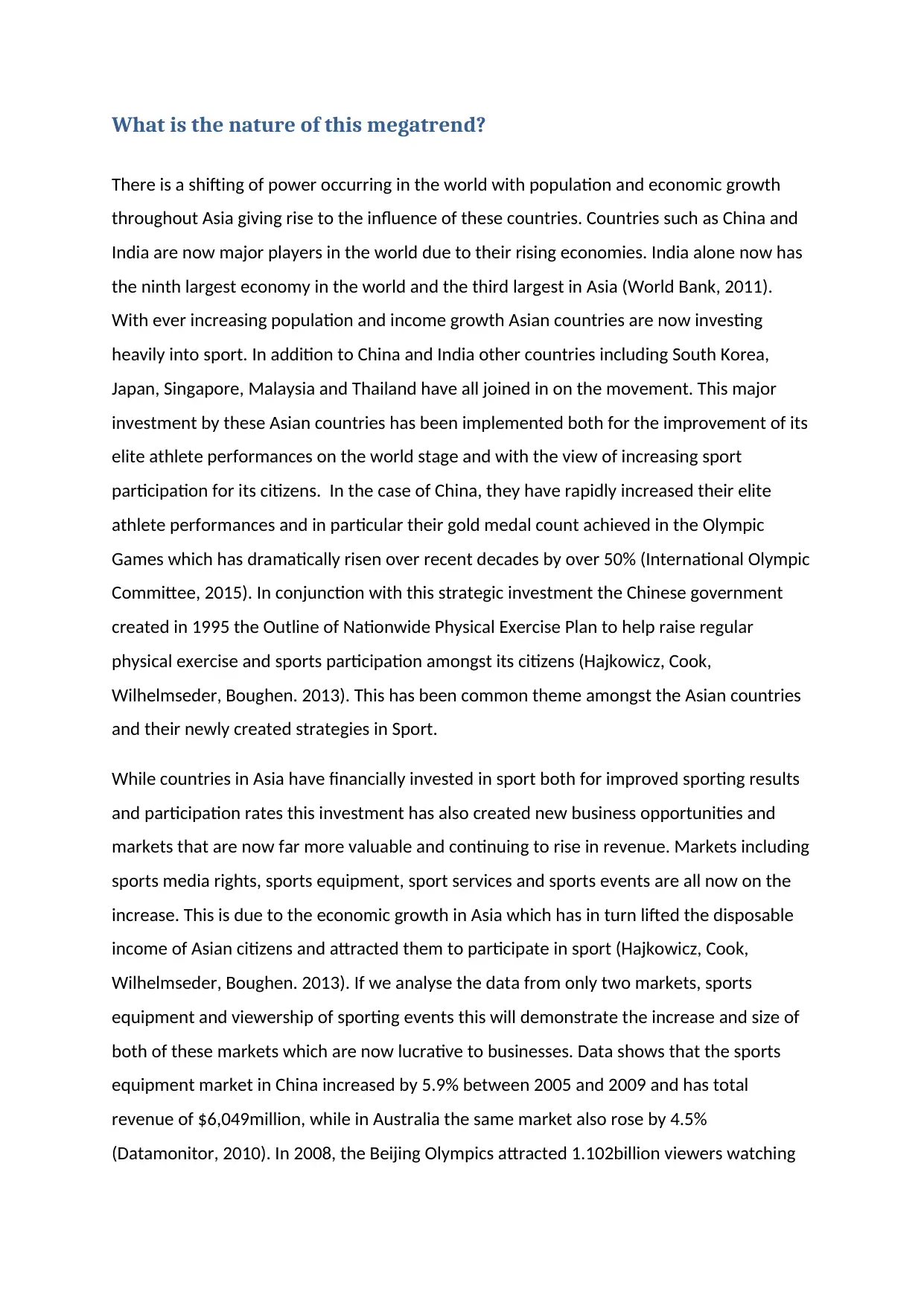
What is the nature of this megatrend?
There is a shifting of power occurring in the world with population and economic growth
throughout Asia giving rise to the influence of these countries. Countries such as China and
India are now major players in the world due to their rising economies. India alone now has
the ninth largest economy in the world and the third largest in Asia (World Bank, 2011).
With ever increasing population and income growth Asian countries are now investing
heavily into sport. In addition to China and India other countries including South Korea,
Japan, Singapore, Malaysia and Thailand have all joined in on the movement. This major
investment by these Asian countries has been implemented both for the improvement of its
elite athlete performances on the world stage and with the view of increasing sport
participation for its citizens. In the case of China, they have rapidly increased their elite
athlete performances and in particular their gold medal count achieved in the Olympic
Games which has dramatically risen over recent decades by over 50% (International Olympic
Committee, 2015). In conjunction with this strategic investment the Chinese government
created in 1995 the Outline of Nationwide Physical Exercise Plan to help raise regular
physical exercise and sports participation amongst its citizens (Hajkowicz, Cook,
Wilhelmseder, Boughen. 2013). This has been common theme amongst the Asian countries
and their newly created strategies in Sport.
While countries in Asia have financially invested in sport both for improved sporting results
and participation rates this investment has also created new business opportunities and
markets that are now far more valuable and continuing to rise in revenue. Markets including
sports media rights, sports equipment, sport services and sports events are all now on the
increase. This is due to the economic growth in Asia which has in turn lifted the disposable
income of Asian citizens and attracted them to participate in sport (Hajkowicz, Cook,
Wilhelmseder, Boughen. 2013). If we analyse the data from only two markets, sports
equipment and viewership of sporting events this will demonstrate the increase and size of
both of these markets which are now lucrative to businesses. Data shows that the sports
equipment market in China increased by 5.9% between 2005 and 2009 and has total
revenue of $6,049million, while in Australia the same market also rose by 4.5%
(Datamonitor, 2010). In 2008, the Beijing Olympics attracted 1.102billion viewers watching
There is a shifting of power occurring in the world with population and economic growth
throughout Asia giving rise to the influence of these countries. Countries such as China and
India are now major players in the world due to their rising economies. India alone now has
the ninth largest economy in the world and the third largest in Asia (World Bank, 2011).
With ever increasing population and income growth Asian countries are now investing
heavily into sport. In addition to China and India other countries including South Korea,
Japan, Singapore, Malaysia and Thailand have all joined in on the movement. This major
investment by these Asian countries has been implemented both for the improvement of its
elite athlete performances on the world stage and with the view of increasing sport
participation for its citizens. In the case of China, they have rapidly increased their elite
athlete performances and in particular their gold medal count achieved in the Olympic
Games which has dramatically risen over recent decades by over 50% (International Olympic
Committee, 2015). In conjunction with this strategic investment the Chinese government
created in 1995 the Outline of Nationwide Physical Exercise Plan to help raise regular
physical exercise and sports participation amongst its citizens (Hajkowicz, Cook,
Wilhelmseder, Boughen. 2013). This has been common theme amongst the Asian countries
and their newly created strategies in Sport.
While countries in Asia have financially invested in sport both for improved sporting results
and participation rates this investment has also created new business opportunities and
markets that are now far more valuable and continuing to rise in revenue. Markets including
sports media rights, sports equipment, sport services and sports events are all now on the
increase. This is due to the economic growth in Asia which has in turn lifted the disposable
income of Asian citizens and attracted them to participate in sport (Hajkowicz, Cook,
Wilhelmseder, Boughen. 2013). If we analyse the data from only two markets, sports
equipment and viewership of sporting events this will demonstrate the increase and size of
both of these markets which are now lucrative to businesses. Data shows that the sports
equipment market in China increased by 5.9% between 2005 and 2009 and has total
revenue of $6,049million, while in Australia the same market also rose by 4.5%
(Datamonitor, 2010). In 2008, the Beijing Olympics attracted 1.102billion viewers watching
⊘ This is a preview!⊘
Do you want full access?
Subscribe today to unlock all pages.

Trusted by 1+ million students worldwide
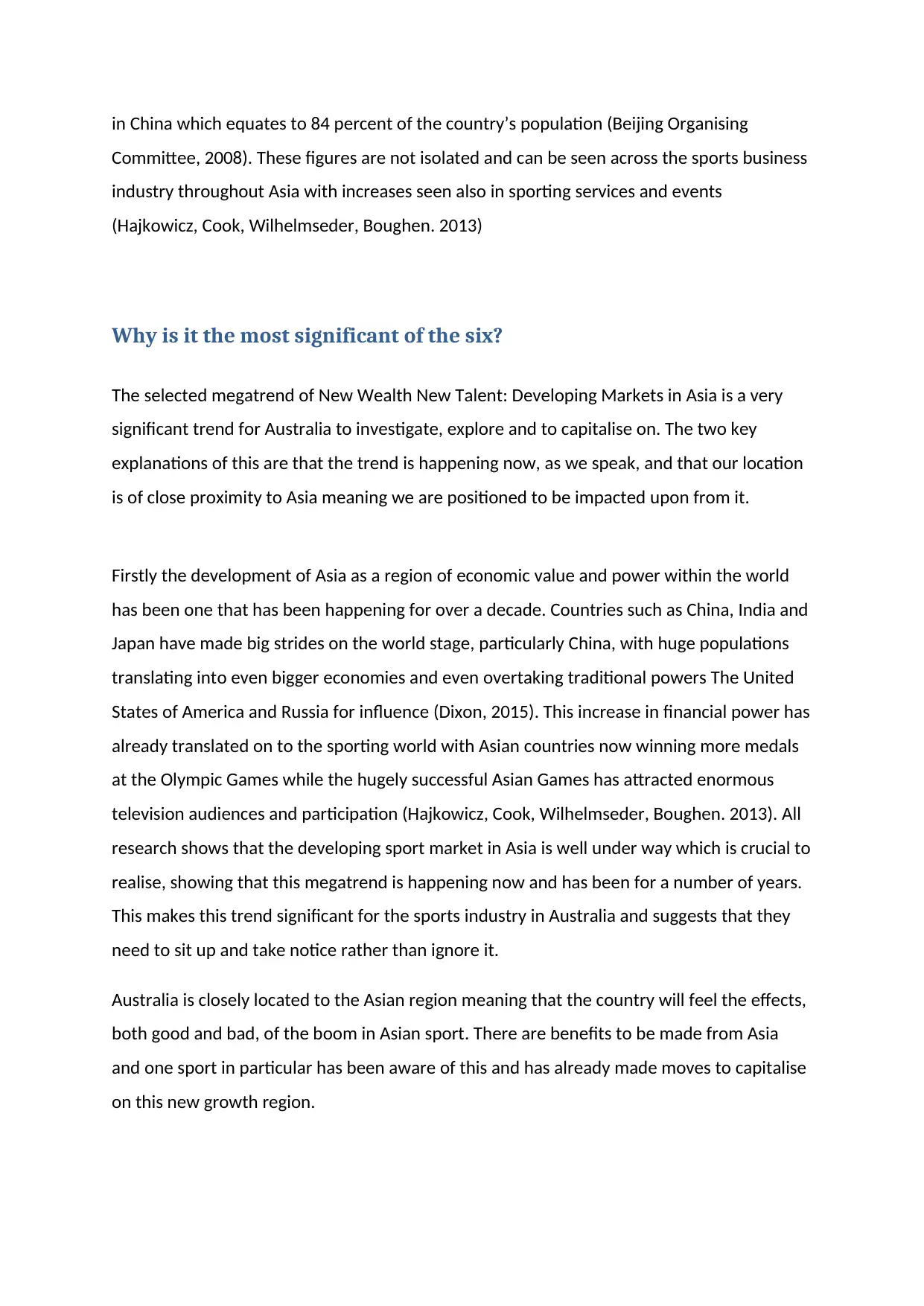
in China which equates to 84 percent of the country’s population (Beijing Organising
Committee, 2008). These figures are not isolated and can be seen across the sports business
industry throughout Asia with increases seen also in sporting services and events
(Hajkowicz, Cook, Wilhelmseder, Boughen. 2013)
Why is it the most significant of the six?
The selected megatrend of New Wealth New Talent: Developing Markets in Asia is a very
significant trend for Australia to investigate, explore and to capitalise on. The two key
explanations of this are that the trend is happening now, as we speak, and that our location
is of close proximity to Asia meaning we are positioned to be impacted upon from it.
Firstly the development of Asia as a region of economic value and power within the world
has been one that has been happening for over a decade. Countries such as China, India and
Japan have made big strides on the world stage, particularly China, with huge populations
translating into even bigger economies and even overtaking traditional powers The United
States of America and Russia for influence (Dixon, 2015). This increase in financial power has
already translated on to the sporting world with Asian countries now winning more medals
at the Olympic Games while the hugely successful Asian Games has attracted enormous
television audiences and participation (Hajkowicz, Cook, Wilhelmseder, Boughen. 2013). All
research shows that the developing sport market in Asia is well under way which is crucial to
realise, showing that this megatrend is happening now and has been for a number of years.
This makes this trend significant for the sports industry in Australia and suggests that they
need to sit up and take notice rather than ignore it.
Australia is closely located to the Asian region meaning that the country will feel the effects,
both good and bad, of the boom in Asian sport. There are benefits to be made from Asia
and one sport in particular has been aware of this and has already made moves to capitalise
on this new growth region.
Committee, 2008). These figures are not isolated and can be seen across the sports business
industry throughout Asia with increases seen also in sporting services and events
(Hajkowicz, Cook, Wilhelmseder, Boughen. 2013)
Why is it the most significant of the six?
The selected megatrend of New Wealth New Talent: Developing Markets in Asia is a very
significant trend for Australia to investigate, explore and to capitalise on. The two key
explanations of this are that the trend is happening now, as we speak, and that our location
is of close proximity to Asia meaning we are positioned to be impacted upon from it.
Firstly the development of Asia as a region of economic value and power within the world
has been one that has been happening for over a decade. Countries such as China, India and
Japan have made big strides on the world stage, particularly China, with huge populations
translating into even bigger economies and even overtaking traditional powers The United
States of America and Russia for influence (Dixon, 2015). This increase in financial power has
already translated on to the sporting world with Asian countries now winning more medals
at the Olympic Games while the hugely successful Asian Games has attracted enormous
television audiences and participation (Hajkowicz, Cook, Wilhelmseder, Boughen. 2013). All
research shows that the developing sport market in Asia is well under way which is crucial to
realise, showing that this megatrend is happening now and has been for a number of years.
This makes this trend significant for the sports industry in Australia and suggests that they
need to sit up and take notice rather than ignore it.
Australia is closely located to the Asian region meaning that the country will feel the effects,
both good and bad, of the boom in Asian sport. There are benefits to be made from Asia
and one sport in particular has been aware of this and has already made moves to capitalise
on this new growth region.
Paraphrase This Document
Need a fresh take? Get an instant paraphrase of this document with our AI Paraphraser
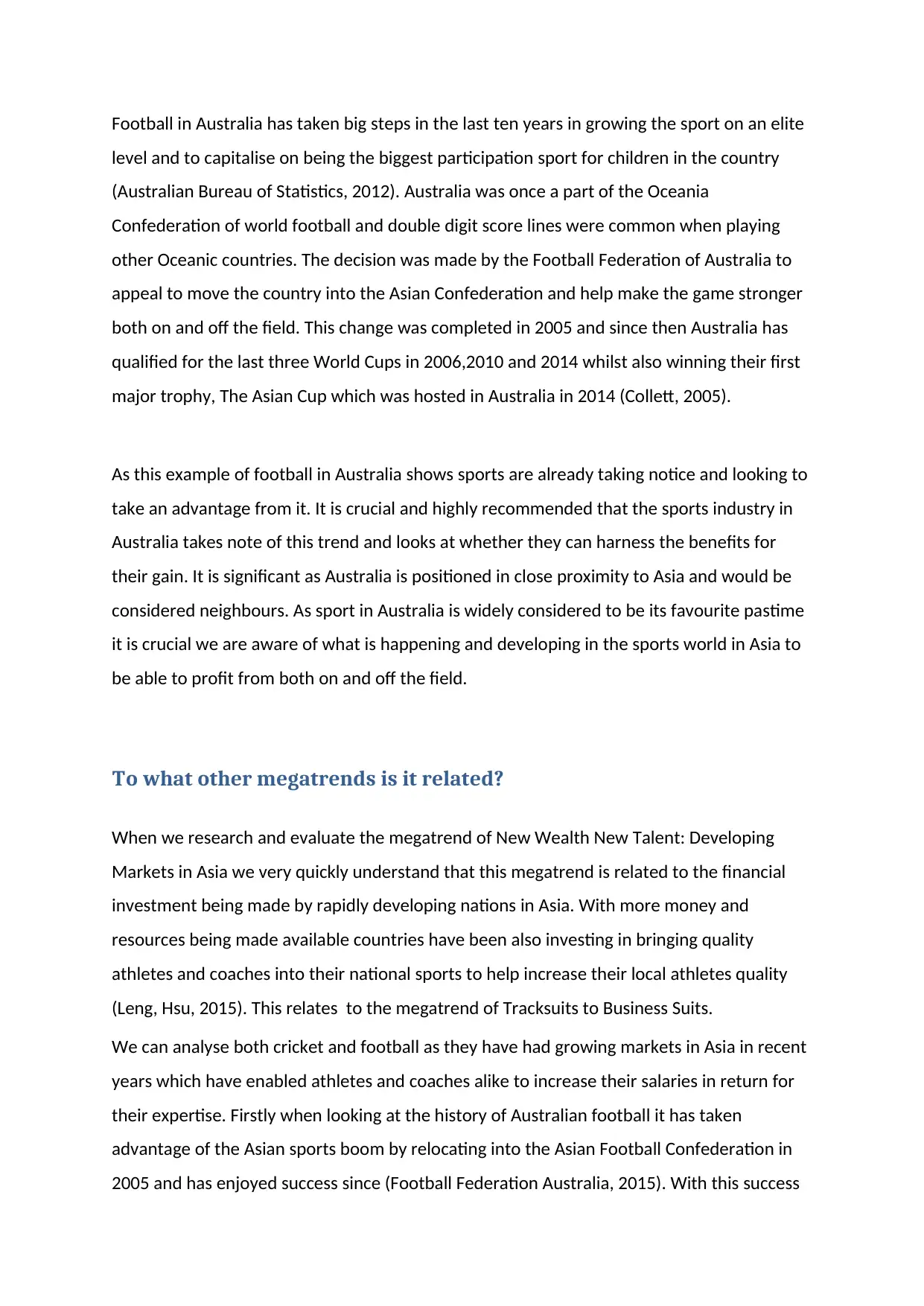
Football in Australia has taken big steps in the last ten years in growing the sport on an elite
level and to capitalise on being the biggest participation sport for children in the country
(Australian Bureau of Statistics, 2012). Australia was once a part of the Oceania
Confederation of world football and double digit score lines were common when playing
other Oceanic countries. The decision was made by the Football Federation of Australia to
appeal to move the country into the Asian Confederation and help make the game stronger
both on and off the field. This change was completed in 2005 and since then Australia has
qualified for the last three World Cups in 2006,2010 and 2014 whilst also winning their first
major trophy, The Asian Cup which was hosted in Australia in 2014 (Collett, 2005).
As this example of football in Australia shows sports are already taking notice and looking to
take an advantage from it. It is crucial and highly recommended that the sports industry in
Australia takes note of this trend and looks at whether they can harness the benefits for
their gain. It is significant as Australia is positioned in close proximity to Asia and would be
considered neighbours. As sport in Australia is widely considered to be its favourite pastime
it is crucial we are aware of what is happening and developing in the sports world in Asia to
be able to profit from both on and off the field.
To what other megatrends is it related?
When we research and evaluate the megatrend of New Wealth New Talent: Developing
Markets in Asia we very quickly understand that this megatrend is related to the financial
investment being made by rapidly developing nations in Asia. With more money and
resources being made available countries have been also investing in bringing quality
athletes and coaches into their national sports to help increase their local athletes quality
(Leng, Hsu, 2015). This relates to the megatrend of Tracksuits to Business Suits.
We can analyse both cricket and football as they have had growing markets in Asia in recent
years which have enabled athletes and coaches alike to increase their salaries in return for
their expertise. Firstly when looking at the history of Australian football it has taken
advantage of the Asian sports boom by relocating into the Asian Football Confederation in
2005 and has enjoyed success since (Football Federation Australia, 2015). With this success
level and to capitalise on being the biggest participation sport for children in the country
(Australian Bureau of Statistics, 2012). Australia was once a part of the Oceania
Confederation of world football and double digit score lines were common when playing
other Oceanic countries. The decision was made by the Football Federation of Australia to
appeal to move the country into the Asian Confederation and help make the game stronger
both on and off the field. This change was completed in 2005 and since then Australia has
qualified for the last three World Cups in 2006,2010 and 2014 whilst also winning their first
major trophy, The Asian Cup which was hosted in Australia in 2014 (Collett, 2005).
As this example of football in Australia shows sports are already taking notice and looking to
take an advantage from it. It is crucial and highly recommended that the sports industry in
Australia takes note of this trend and looks at whether they can harness the benefits for
their gain. It is significant as Australia is positioned in close proximity to Asia and would be
considered neighbours. As sport in Australia is widely considered to be its favourite pastime
it is crucial we are aware of what is happening and developing in the sports world in Asia to
be able to profit from both on and off the field.
To what other megatrends is it related?
When we research and evaluate the megatrend of New Wealth New Talent: Developing
Markets in Asia we very quickly understand that this megatrend is related to the financial
investment being made by rapidly developing nations in Asia. With more money and
resources being made available countries have been also investing in bringing quality
athletes and coaches into their national sports to help increase their local athletes quality
(Leng, Hsu, 2015). This relates to the megatrend of Tracksuits to Business Suits.
We can analyse both cricket and football as they have had growing markets in Asia in recent
years which have enabled athletes and coaches alike to increase their salaries in return for
their expertise. Firstly when looking at the history of Australian football it has taken
advantage of the Asian sports boom by relocating into the Asian Football Confederation in
2005 and has enjoyed success since (Football Federation Australia, 2015). With this success
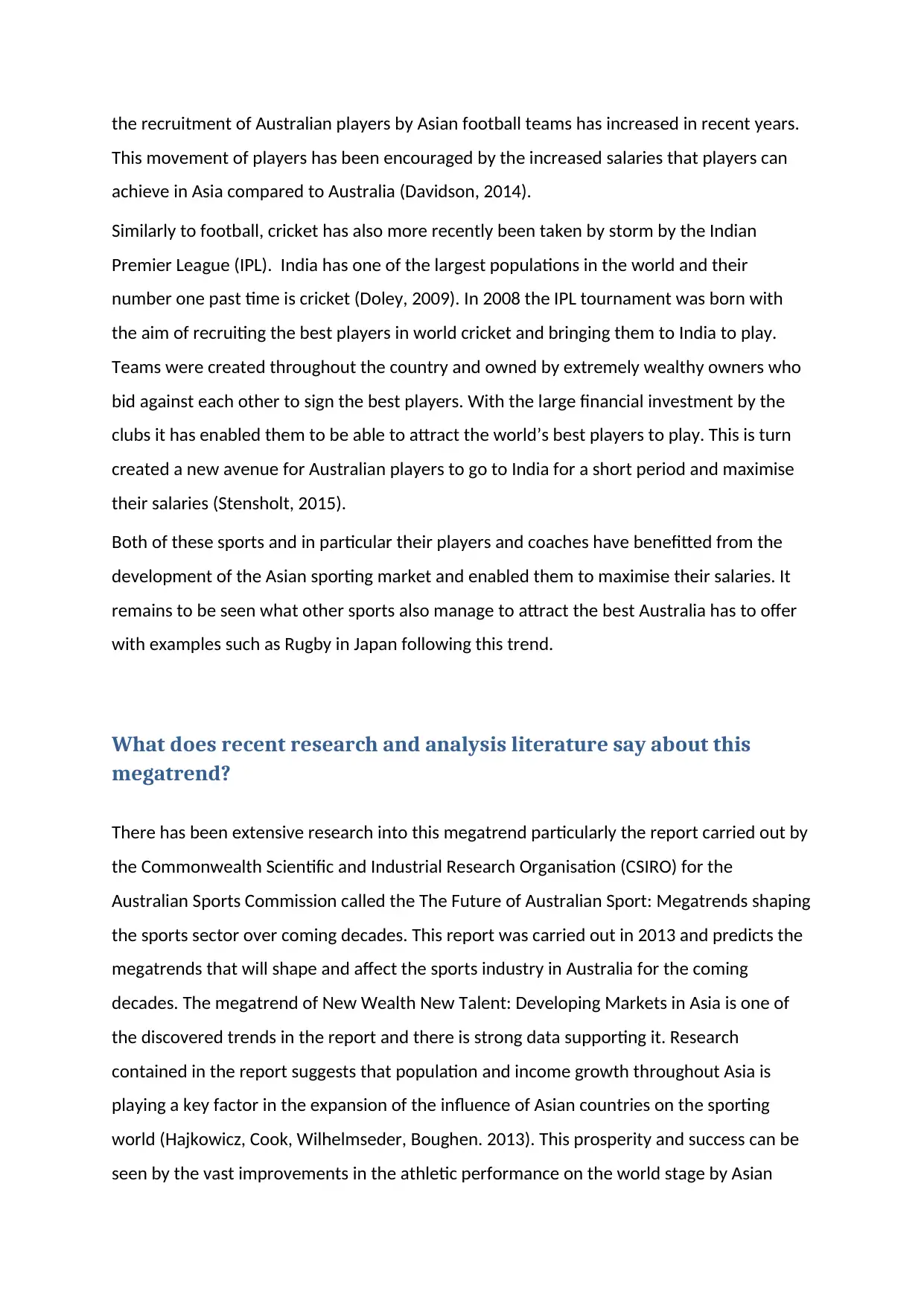
the recruitment of Australian players by Asian football teams has increased in recent years.
This movement of players has been encouraged by the increased salaries that players can
achieve in Asia compared to Australia (Davidson, 2014).
Similarly to football, cricket has also more recently been taken by storm by the Indian
Premier League (IPL). India has one of the largest populations in the world and their
number one past time is cricket (Doley, 2009). In 2008 the IPL tournament was born with
the aim of recruiting the best players in world cricket and bringing them to India to play.
Teams were created throughout the country and owned by extremely wealthy owners who
bid against each other to sign the best players. With the large financial investment by the
clubs it has enabled them to be able to attract the world’s best players to play. This is turn
created a new avenue for Australian players to go to India for a short period and maximise
their salaries (Stensholt, 2015).
Both of these sports and in particular their players and coaches have benefitted from the
development of the Asian sporting market and enabled them to maximise their salaries. It
remains to be seen what other sports also manage to attract the best Australia has to offer
with examples such as Rugby in Japan following this trend.
What does recent research and analysis literature say about this
megatrend?
There has been extensive research into this megatrend particularly the report carried out by
the Commonwealth Scientific and Industrial Research Organisation (CSIRO) for the
Australian Sports Commission called the The Future of Australian Sport: Megatrends shaping
the sports sector over coming decades. This report was carried out in 2013 and predicts the
megatrends that will shape and affect the sports industry in Australia for the coming
decades. The megatrend of New Wealth New Talent: Developing Markets in Asia is one of
the discovered trends in the report and there is strong data supporting it. Research
contained in the report suggests that population and income growth throughout Asia is
playing a key factor in the expansion of the influence of Asian countries on the sporting
world (Hajkowicz, Cook, Wilhelmseder, Boughen. 2013). This prosperity and success can be
seen by the vast improvements in the athletic performance on the world stage by Asian
This movement of players has been encouraged by the increased salaries that players can
achieve in Asia compared to Australia (Davidson, 2014).
Similarly to football, cricket has also more recently been taken by storm by the Indian
Premier League (IPL). India has one of the largest populations in the world and their
number one past time is cricket (Doley, 2009). In 2008 the IPL tournament was born with
the aim of recruiting the best players in world cricket and bringing them to India to play.
Teams were created throughout the country and owned by extremely wealthy owners who
bid against each other to sign the best players. With the large financial investment by the
clubs it has enabled them to be able to attract the world’s best players to play. This is turn
created a new avenue for Australian players to go to India for a short period and maximise
their salaries (Stensholt, 2015).
Both of these sports and in particular their players and coaches have benefitted from the
development of the Asian sporting market and enabled them to maximise their salaries. It
remains to be seen what other sports also manage to attract the best Australia has to offer
with examples such as Rugby in Japan following this trend.
What does recent research and analysis literature say about this
megatrend?
There has been extensive research into this megatrend particularly the report carried out by
the Commonwealth Scientific and Industrial Research Organisation (CSIRO) for the
Australian Sports Commission called the The Future of Australian Sport: Megatrends shaping
the sports sector over coming decades. This report was carried out in 2013 and predicts the
megatrends that will shape and affect the sports industry in Australia for the coming
decades. The megatrend of New Wealth New Talent: Developing Markets in Asia is one of
the discovered trends in the report and there is strong data supporting it. Research
contained in the report suggests that population and income growth throughout Asia is
playing a key factor in the expansion of the influence of Asian countries on the sporting
world (Hajkowicz, Cook, Wilhelmseder, Boughen. 2013). This prosperity and success can be
seen by the vast improvements in the athletic performance on the world stage by Asian
⊘ This is a preview!⊘
Do you want full access?
Subscribe today to unlock all pages.

Trusted by 1+ million students worldwide
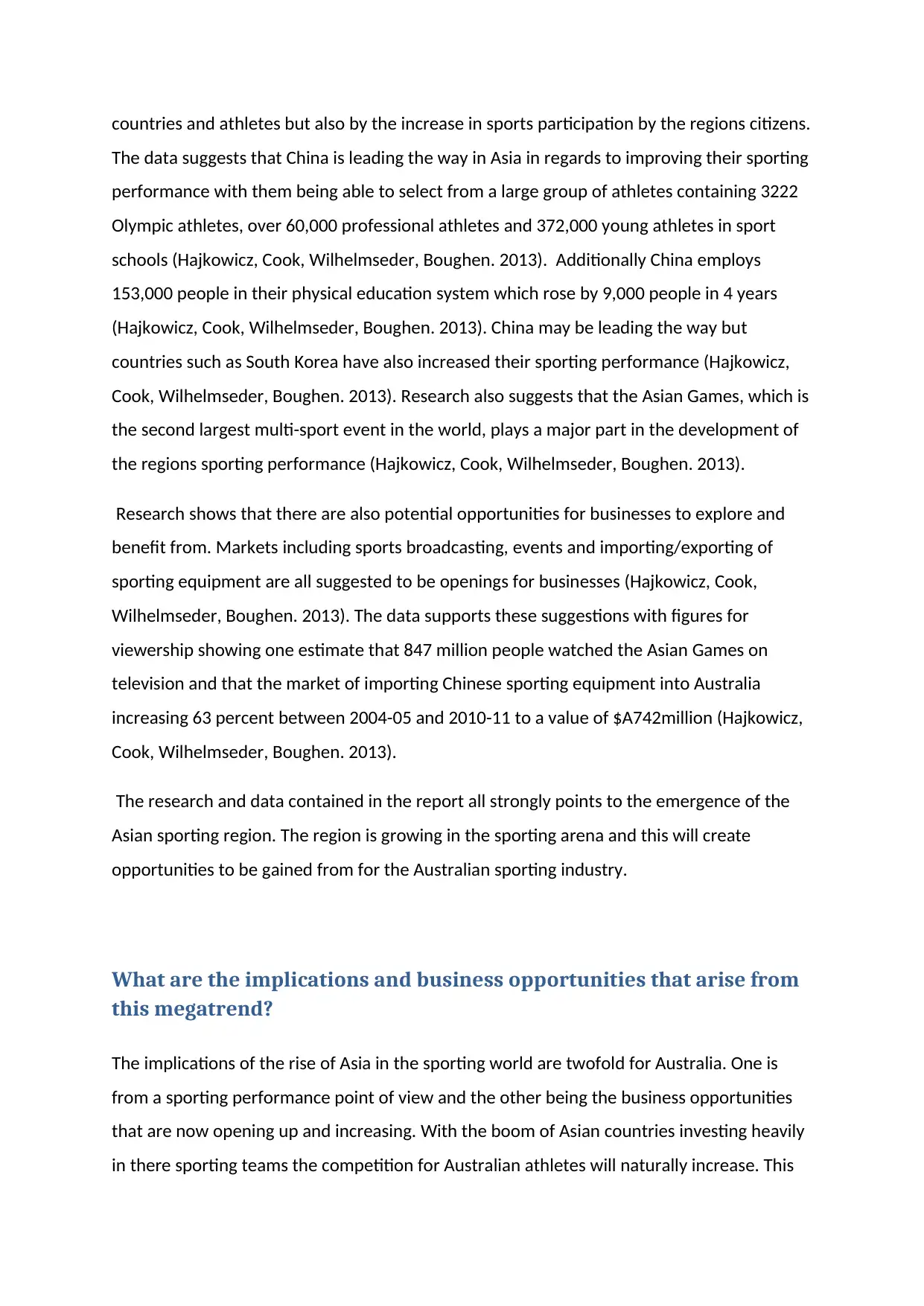
countries and athletes but also by the increase in sports participation by the regions citizens.
The data suggests that China is leading the way in Asia in regards to improving their sporting
performance with them being able to select from a large group of athletes containing 3222
Olympic athletes, over 60,000 professional athletes and 372,000 young athletes in sport
schools (Hajkowicz, Cook, Wilhelmseder, Boughen. 2013). Additionally China employs
153,000 people in their physical education system which rose by 9,000 people in 4 years
(Hajkowicz, Cook, Wilhelmseder, Boughen. 2013). China may be leading the way but
countries such as South Korea have also increased their sporting performance (Hajkowicz,
Cook, Wilhelmseder, Boughen. 2013). Research also suggests that the Asian Games, which is
the second largest multi-sport event in the world, plays a major part in the development of
the regions sporting performance (Hajkowicz, Cook, Wilhelmseder, Boughen. 2013).
Research shows that there are also potential opportunities for businesses to explore and
benefit from. Markets including sports broadcasting, events and importing/exporting of
sporting equipment are all suggested to be openings for businesses (Hajkowicz, Cook,
Wilhelmseder, Boughen. 2013). The data supports these suggestions with figures for
viewership showing one estimate that 847 million people watched the Asian Games on
television and that the market of importing Chinese sporting equipment into Australia
increasing 63 percent between 2004-05 and 2010-11 to a value of $A742million (Hajkowicz,
Cook, Wilhelmseder, Boughen. 2013).
The research and data contained in the report all strongly points to the emergence of the
Asian sporting region. The region is growing in the sporting arena and this will create
opportunities to be gained from for the Australian sporting industry.
What are the implications and business opportunities that arise from
this megatrend?
The implications of the rise of Asia in the sporting world are twofold for Australia. One is
from a sporting performance point of view and the other being the business opportunities
that are now opening up and increasing. With the boom of Asian countries investing heavily
in there sporting teams the competition for Australian athletes will naturally increase. This
The data suggests that China is leading the way in Asia in regards to improving their sporting
performance with them being able to select from a large group of athletes containing 3222
Olympic athletes, over 60,000 professional athletes and 372,000 young athletes in sport
schools (Hajkowicz, Cook, Wilhelmseder, Boughen. 2013). Additionally China employs
153,000 people in their physical education system which rose by 9,000 people in 4 years
(Hajkowicz, Cook, Wilhelmseder, Boughen. 2013). China may be leading the way but
countries such as South Korea have also increased their sporting performance (Hajkowicz,
Cook, Wilhelmseder, Boughen. 2013). Research also suggests that the Asian Games, which is
the second largest multi-sport event in the world, plays a major part in the development of
the regions sporting performance (Hajkowicz, Cook, Wilhelmseder, Boughen. 2013).
Research shows that there are also potential opportunities for businesses to explore and
benefit from. Markets including sports broadcasting, events and importing/exporting of
sporting equipment are all suggested to be openings for businesses (Hajkowicz, Cook,
Wilhelmseder, Boughen. 2013). The data supports these suggestions with figures for
viewership showing one estimate that 847 million people watched the Asian Games on
television and that the market of importing Chinese sporting equipment into Australia
increasing 63 percent between 2004-05 and 2010-11 to a value of $A742million (Hajkowicz,
Cook, Wilhelmseder, Boughen. 2013).
The research and data contained in the report all strongly points to the emergence of the
Asian sporting region. The region is growing in the sporting arena and this will create
opportunities to be gained from for the Australian sporting industry.
What are the implications and business opportunities that arise from
this megatrend?
The implications of the rise of Asia in the sporting world are twofold for Australia. One is
from a sporting performance point of view and the other being the business opportunities
that are now opening up and increasing. With the boom of Asian countries investing heavily
in there sporting teams the competition for Australian athletes will naturally increase. This
Paraphrase This Document
Need a fresh take? Get an instant paraphrase of this document with our AI Paraphraser
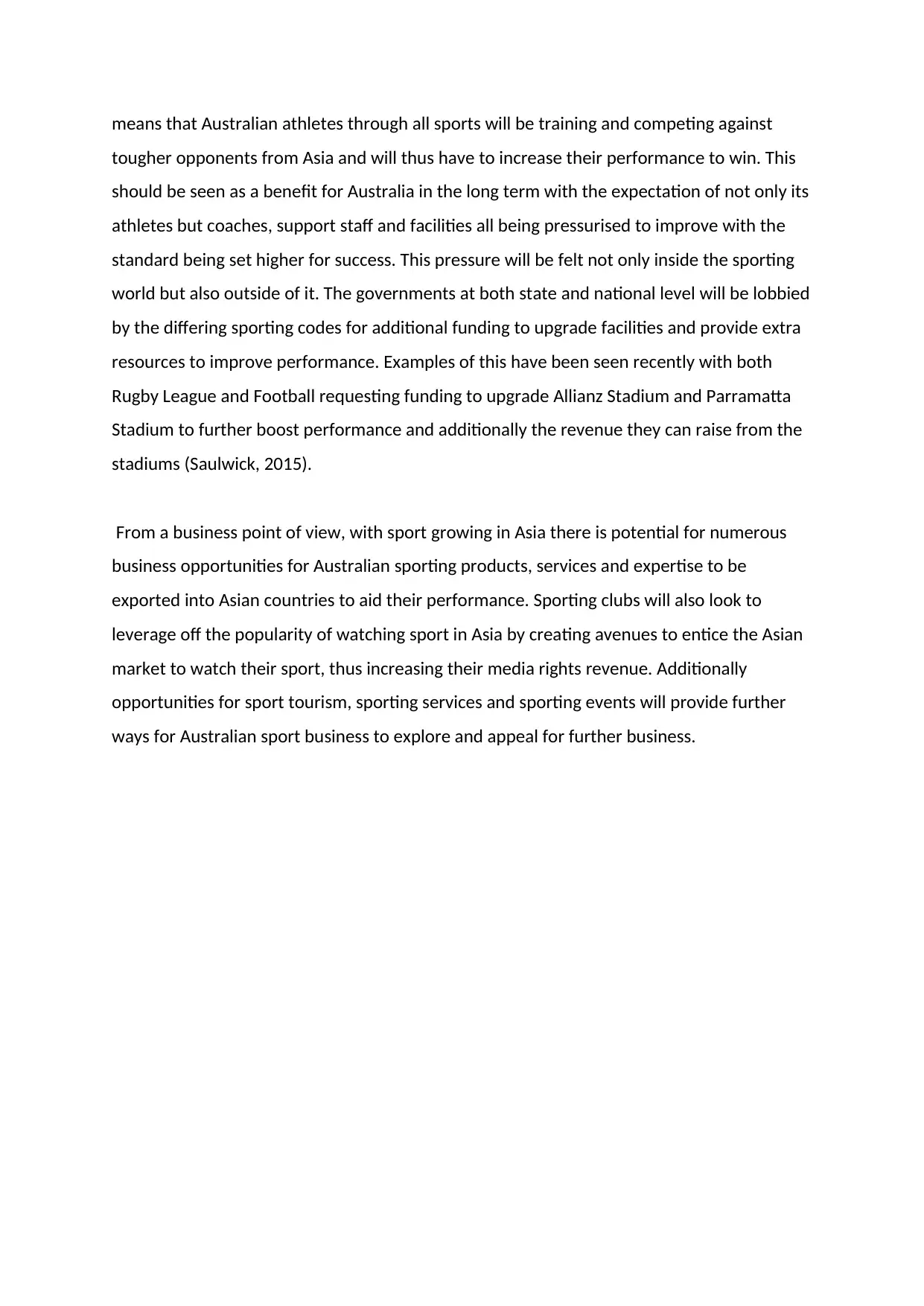
means that Australian athletes through all sports will be training and competing against
tougher opponents from Asia and will thus have to increase their performance to win. This
should be seen as a benefit for Australia in the long term with the expectation of not only its
athletes but coaches, support staff and facilities all being pressurised to improve with the
standard being set higher for success. This pressure will be felt not only inside the sporting
world but also outside of it. The governments at both state and national level will be lobbied
by the differing sporting codes for additional funding to upgrade facilities and provide extra
resources to improve performance. Examples of this have been seen recently with both
Rugby League and Football requesting funding to upgrade Allianz Stadium and Parramatta
Stadium to further boost performance and additionally the revenue they can raise from the
stadiums (Saulwick, 2015).
From a business point of view, with sport growing in Asia there is potential for numerous
business opportunities for Australian sporting products, services and expertise to be
exported into Asian countries to aid their performance. Sporting clubs will also look to
leverage off the popularity of watching sport in Asia by creating avenues to entice the Asian
market to watch their sport, thus increasing their media rights revenue. Additionally
opportunities for sport tourism, sporting services and sporting events will provide further
ways for Australian sport business to explore and appeal for further business.
tougher opponents from Asia and will thus have to increase their performance to win. This
should be seen as a benefit for Australia in the long term with the expectation of not only its
athletes but coaches, support staff and facilities all being pressurised to improve with the
standard being set higher for success. This pressure will be felt not only inside the sporting
world but also outside of it. The governments at both state and national level will be lobbied
by the differing sporting codes for additional funding to upgrade facilities and provide extra
resources to improve performance. Examples of this have been seen recently with both
Rugby League and Football requesting funding to upgrade Allianz Stadium and Parramatta
Stadium to further boost performance and additionally the revenue they can raise from the
stadiums (Saulwick, 2015).
From a business point of view, with sport growing in Asia there is potential for numerous
business opportunities for Australian sporting products, services and expertise to be
exported into Asian countries to aid their performance. Sporting clubs will also look to
leverage off the popularity of watching sport in Asia by creating avenues to entice the Asian
market to watch their sport, thus increasing their media rights revenue. Additionally
opportunities for sport tourism, sporting services and sporting events will provide further
ways for Australian sport business to explore and appeal for further business.
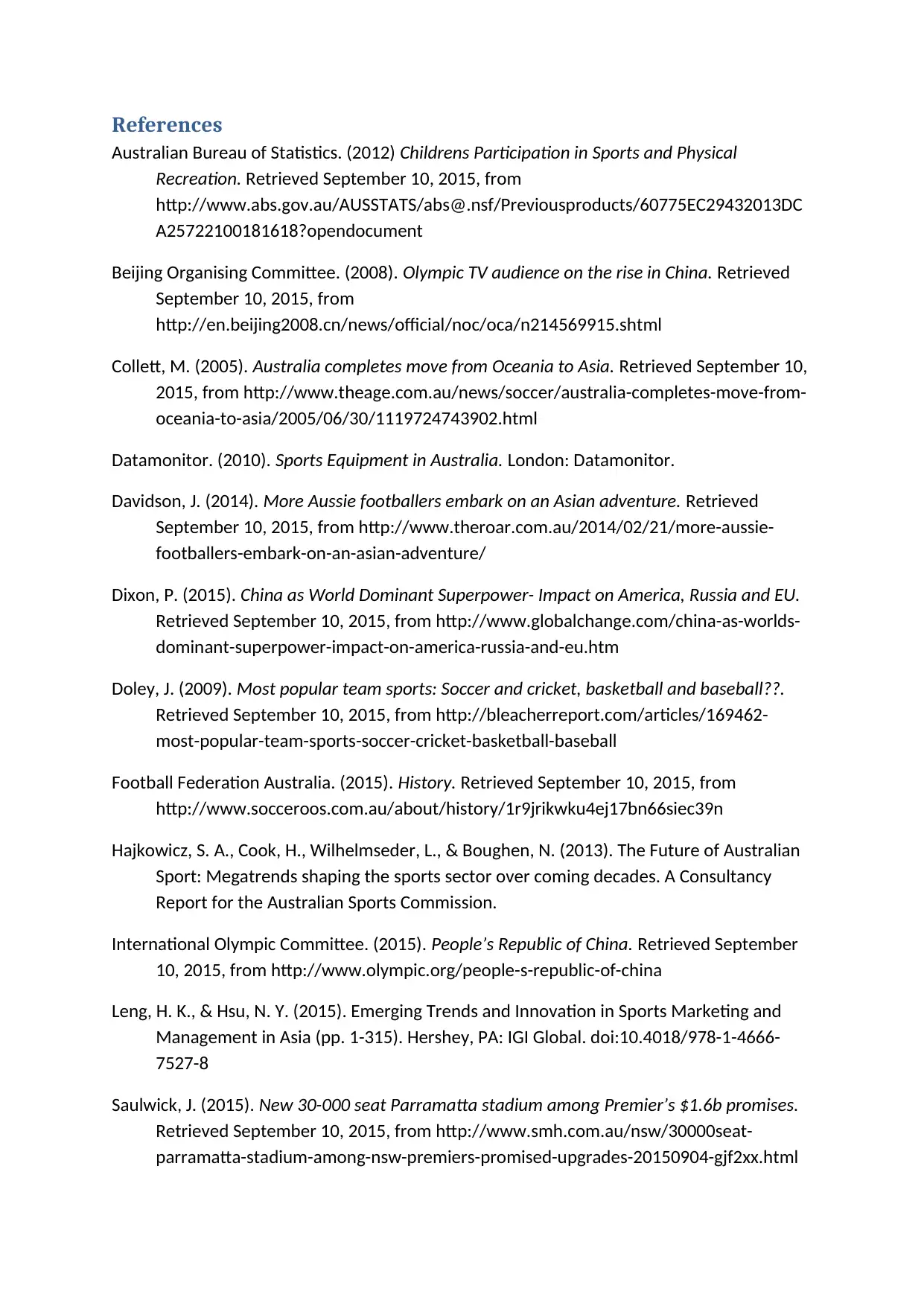
References
Australian Bureau of Statistics. (2012) Childrens Participation in Sports and Physical
Recreation. Retrieved September 10, 2015, from
http://www.abs.gov.au/AUSSTATS/abs@.nsf/Previousproducts/60775EC29432013DC
A25722100181618?opendocument
Beijing Organising Committee. (2008). Olympic TV audience on the rise in China. Retrieved
September 10, 2015, from
http://en.beijing2008.cn/news/official/noc/oca/n214569915.shtml
Collett, M. (2005). Australia completes move from Oceania to Asia. Retrieved September 10,
2015, from http://www.theage.com.au/news/soccer/australia-completes-move-from-
oceania-to-asia/2005/06/30/1119724743902.html
Datamonitor. (2010). Sports Equipment in Australia. London: Datamonitor.
Davidson, J. (2014). More Aussie footballers embark on an Asian adventure. Retrieved
September 10, 2015, from http://www.theroar.com.au/2014/02/21/more-aussie-
footballers-embark-on-an-asian-adventure/
Dixon, P. (2015). China as World Dominant Superpower- Impact on America, Russia and EU.
Retrieved September 10, 2015, from http://www.globalchange.com/china-as-worlds-
dominant-superpower-impact-on-america-russia-and-eu.htm
Doley, J. (2009). Most popular team sports: Soccer and cricket, basketball and baseball??.
Retrieved September 10, 2015, from http://bleacherreport.com/articles/169462-
most-popular-team-sports-soccer-cricket-basketball-baseball
Football Federation Australia. (2015). History. Retrieved September 10, 2015, from
http://www.socceroos.com.au/about/history/1r9jrikwku4ej17bn66siec39n
Hajkowicz, S. A., Cook, H., Wilhelmseder, L., & Boughen, N. (2013). The Future of Australian
Sport: Megatrends shaping the sports sector over coming decades. A Consultancy
Report for the Australian Sports Commission.
International Olympic Committee. (2015). People’s Republic of China. Retrieved September
10, 2015, from http://www.olympic.org/people-s-republic-of-china
Leng, H. K., & Hsu, N. Y. (2015). Emerging Trends and Innovation in Sports Marketing and
Management in Asia (pp. 1-315). Hershey, PA: IGI Global. doi:10.4018/978-1-4666-
7527-8
Saulwick, J. (2015). New 30-000 seat Parramatta stadium among Premier’s $1.6b promises.
Retrieved September 10, 2015, from http://www.smh.com.au/nsw/30000seat-
parramatta-stadium-among-nsw-premiers-promised-upgrades-20150904-gjf2xx.html
Australian Bureau of Statistics. (2012) Childrens Participation in Sports and Physical
Recreation. Retrieved September 10, 2015, from
http://www.abs.gov.au/AUSSTATS/abs@.nsf/Previousproducts/60775EC29432013DC
A25722100181618?opendocument
Beijing Organising Committee. (2008). Olympic TV audience on the rise in China. Retrieved
September 10, 2015, from
http://en.beijing2008.cn/news/official/noc/oca/n214569915.shtml
Collett, M. (2005). Australia completes move from Oceania to Asia. Retrieved September 10,
2015, from http://www.theage.com.au/news/soccer/australia-completes-move-from-
oceania-to-asia/2005/06/30/1119724743902.html
Datamonitor. (2010). Sports Equipment in Australia. London: Datamonitor.
Davidson, J. (2014). More Aussie footballers embark on an Asian adventure. Retrieved
September 10, 2015, from http://www.theroar.com.au/2014/02/21/more-aussie-
footballers-embark-on-an-asian-adventure/
Dixon, P. (2015). China as World Dominant Superpower- Impact on America, Russia and EU.
Retrieved September 10, 2015, from http://www.globalchange.com/china-as-worlds-
dominant-superpower-impact-on-america-russia-and-eu.htm
Doley, J. (2009). Most popular team sports: Soccer and cricket, basketball and baseball??.
Retrieved September 10, 2015, from http://bleacherreport.com/articles/169462-
most-popular-team-sports-soccer-cricket-basketball-baseball
Football Federation Australia. (2015). History. Retrieved September 10, 2015, from
http://www.socceroos.com.au/about/history/1r9jrikwku4ej17bn66siec39n
Hajkowicz, S. A., Cook, H., Wilhelmseder, L., & Boughen, N. (2013). The Future of Australian
Sport: Megatrends shaping the sports sector over coming decades. A Consultancy
Report for the Australian Sports Commission.
International Olympic Committee. (2015). People’s Republic of China. Retrieved September
10, 2015, from http://www.olympic.org/people-s-republic-of-china
Leng, H. K., & Hsu, N. Y. (2015). Emerging Trends and Innovation in Sports Marketing and
Management in Asia (pp. 1-315). Hershey, PA: IGI Global. doi:10.4018/978-1-4666-
7527-8
Saulwick, J. (2015). New 30-000 seat Parramatta stadium among Premier’s $1.6b promises.
Retrieved September 10, 2015, from http://www.smh.com.au/nsw/30000seat-
parramatta-stadium-among-nsw-premiers-promised-upgrades-20150904-gjf2xx.html
⊘ This is a preview!⊘
Do you want full access?
Subscribe today to unlock all pages.

Trusted by 1+ million students worldwide

Stensholt, J. (2015). Australian cricketers cashing in, at home and in Indian Premier League.
Retrieved September 10, 2015, from
http://www.brw.com.au/p/business/australian_cricketers_cashing_league_YcX1hpVD
Op15VdWonORU0L
World Bank. (2011). World Development Indicators. Washington DC: World Bank.
Retrieved September 10, 2015, from
http://www.brw.com.au/p/business/australian_cricketers_cashing_league_YcX1hpVD
Op15VdWonORU0L
World Bank. (2011). World Development Indicators. Washington DC: World Bank.
1 out of 10
Your All-in-One AI-Powered Toolkit for Academic Success.
+13062052269
info@desklib.com
Available 24*7 on WhatsApp / Email
![[object Object]](/_next/static/media/star-bottom.7253800d.svg)
Unlock your academic potential
Copyright © 2020–2025 A2Z Services. All Rights Reserved. Developed and managed by ZUCOL.


